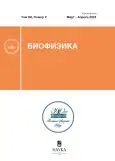Ambiol Modulates the Functional Characteristics of Pea Seedlings Mitochondria
- Autores: Zhigacheva I.V1, Krikunova N.I1, Kuznetsov Y.V1, Goloshchapov A.N1
-
Afiliações:
- N.M. Emanuel Institute of Biochemical Physics, Russian Academy of Sciences
- Edição: Volume 69, Nº 2 (2024)
- Páginas: 271-276
- Seção: Articles
- URL: https://journals.rcsi.science/0006-3029/article/view/257575
- DOI: https://doi.org/10.31857/S0006302924020073
- EDN: https://elibrary.ru/OUZHUV
- ID: 257575
Citar
Texto integral
Resumo
Palavras-chave
Sobre autores
I. Zhigacheva
N.M. Emanuel Institute of Biochemical Physics, Russian Academy of Sciences
Email: zhigacheva@mail.ru
Moscow, Russia
N. Krikunova
N.M. Emanuel Institute of Biochemical Physics, Russian Academy of SciencesMoscow, Russia
Yu. Kuznetsov
N.M. Emanuel Institute of Biochemical Physics, Russian Academy of SciencesMoscow, Russia
A. Goloshchapov
N.M. Emanuel Institute of Biochemical Physics, Russian Academy of SciencesMoscow, Russia
Bibliografia
- Farooq M. A., Niazi A. K., Akhtar J., Saifullah, M. Farooq, Souri Z., Karimi N., and Rengel Z. Plant Physiol. Biochem., 141, 353–369 (2019). doi: 10.1016/j.plaphy.2019.04.039
- Шиков А. Е., Чиркова Т. В. и Емельянов В. В. Функции активных форм кислорода в растительных клетках в норме и при адаптации. Экологическая генетика, 19 (4), 343–363 (2021). doi: 10.17816/ecogen75975
- Колупаев Ю. Е. и Карпец Ю. В. Активные формы кислорода и стрессовый сигналинг у растений. Укр. биохим. журн., 86 (4), 18–35 (2014).
- Благонравов М. Л., Азова М. М. и Фролов В. А. Программированная клеточная гибель в патологии сердца («Литтерра», М., 2013).
- Новодережкина Е. А., Животовский Б. Д. и Гогвадзе В. Г. Индукция неспецифической проницаемости митохондриальной мембраны и ее роль в гибели клеток. Молекуляр. биология, 50 (1), 51–68 (2016). doi: 10.7868/S002689841601016X
- Кирсанова Е. В. и Кириллова И. Г. Влияние препарата амбиол на продукционный процесс гороха и картофеля. Вестн. ОрелГАУ, № 4 (7), 7–9 (2007).
- Войников В. К. Митохондрии растений при температурном стрессе («Гео», Новосибирск, 2011).
- Попов В. Н., Рууге Э. К. и Старков А. А. Влияние ингибиторов электронного транспорта на образование активных форм кислорода при окислении сукцината митохондриями гороха. Биохимия, 68 (7), 910–916 (2003).
- Fletcher B. I., Dillard C. D., and Tappel A. L. Measurement of fluorescent lipid peroxidation products in biological systems and tissues. Anal. Biochem., 52 (1), 1–9 (1973). doi: 10.1016/0003-2697(73)90327-8
- Carreau J. P. and Dubacq J. P. Adaptation of a macroscale method to the micro-scale for fatty acid methyl transesterification of biological lipid extracts. J. Chromatogr., 151 (3), 384–390 (1979) doi: 10.1016/S0021-9673(00)88356-9
- Wang J., Sunwoo H., Cherian G., and Sim J. S. Fatty acid determination in chicken egg yolk: a comparison of different methods. Poultry Sci., 79 (8), 1168–1171 (2000). doi: 10.1093/ps/79.8.1168
- Golovina R. V. and Kuzmenko T. E. Thermodynamic evaluation of the interaction of fatty acid methyl esters with polar and non-polar stationary phases, based on their retention indices. Сhromatographia, 10 (9), 545–548 (1977). doi: 10.1007/BF02262915
- Шакирова Ф. М. Неспецифическая устойчивость растений к стрессовым факторам и ее регуляция («Гилем», Уфа, 2001).
- Пальченко А. К., Пальченко С. А. и Сторожишина К. М. Влияние стимуляторов роста на биометрические показатели сеянцев сосны обыкновенной. Лесное хозяйство, № 2, 297–301 (2008).
- Дубинская Н. И. и Обручева Н. В. в сб. Физиология семян: формирование, прорастание, прикладные аспекты. Отв. ред. Х. Х. Каримов («Дониш», Душанбе, 1990), сс. 181–183.
- Евсюнина А. С. Влияние эпибрассинолида и амбиола на гормональный баланс и ультраструктуру тканей растений картофеля при регуляции ростовых процессов в онтогенезе. Дис. … канд. биол. наук (Институт биохимии им. А.Н. Баха, М., 2006).
- Zhou Y., Peisker H., and Dörmann P. Molecular species composition of plant cardiolipin determined by liquid chromatography mass spectrometry. J. Lipid Res., 57 (7), 1308–1321 (2016). DOI: 10.1194/ jlr.D068429
Arquivos suplementares









